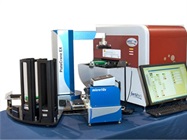
Biomolecular Interaction Analysis: High-throughput Characterization Technology
Biomolecular interaction analysis can help to determine how biomolecules interact with each other and the results of the interactions. Important in medical research and in the pharmaceutical industry, biomolecular interaction analysis allows us to know what happens when different molecules encounter each other.
There are ways to analyze how they bind, the bond strength, and the physical changes that occur with the binding. Biomolecular bond analysis can help us understand the way our bodies work.
Types of Biomolecular Interaction Analysis
There are several types of biomolecular interaction analysis, which include:
- Surface plasmon resonance
- Isothermal titration calorimetry
- Fluorescence resonance energy transfer
Surface plasmon resonance measures how fast mass is being added or subtracted during interactions; isothermal titration calorimetry measures the thermodynamics of an interaction; and fluorescence resonance energy transfer measures the energy transfer between the molecules.




Considerations for purchasing a Biomolecular Interaction Analyzer System
To choose the right biomolecular interaction analysis equipment, determine which parameters you need to analyze, what type of molecules you will be studying, and the desired number and speed of tests.
Click on the links to discover and compare Biomolecular Interaction Analyzers from various manufacturers: